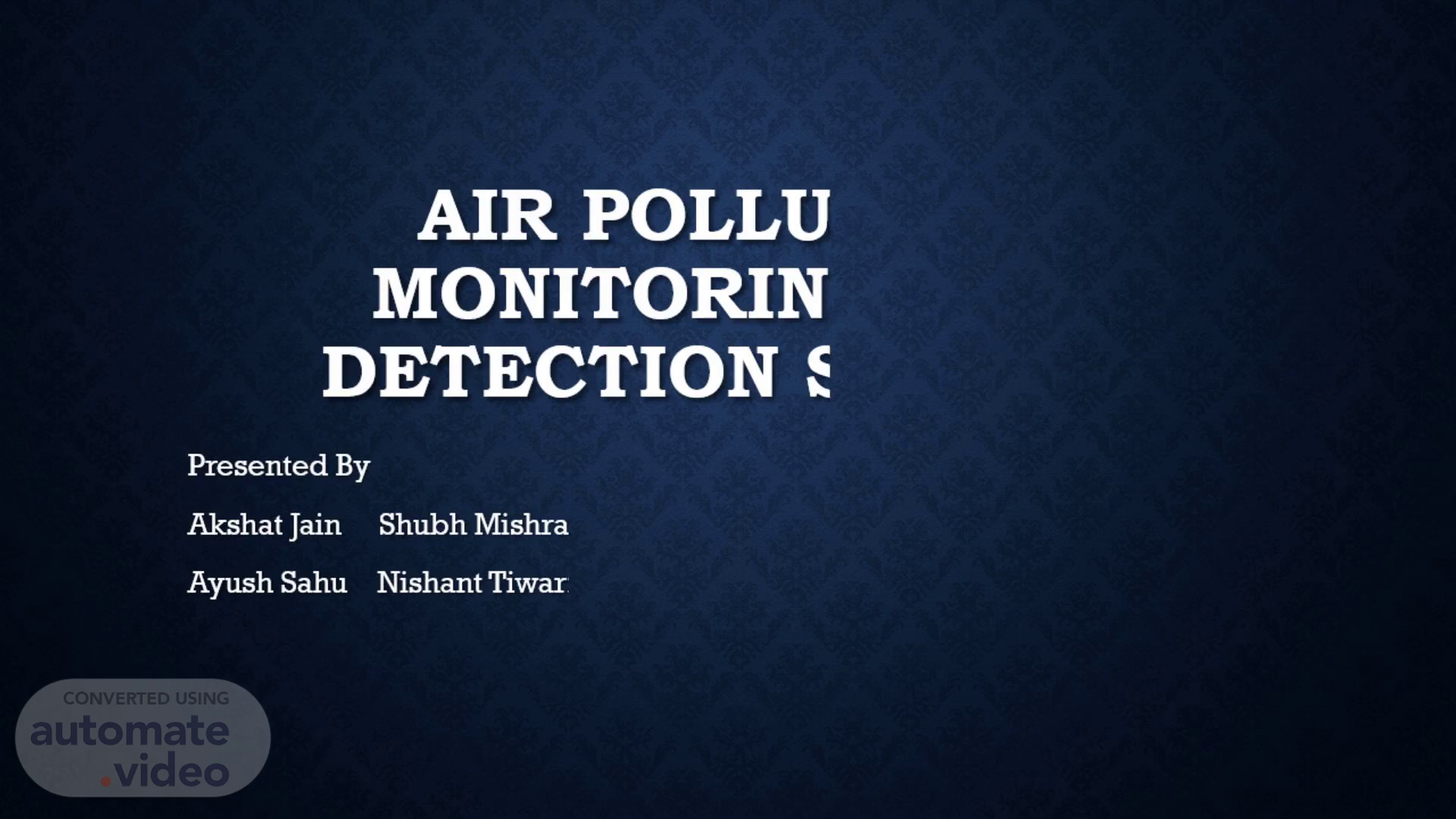Scene 1 (0s)
Air Pollution Monitoring and Detection System. Presented By Presented to Akshat Jain Shubh Mishra Prof. Megha Bairagi Ayush Sahu Nishant Tiwari.
Scene 2 (9s)
Introduction. Air pollution poses significant threats to health and the environment. Leveraging the Internet of Things (IoT) for air pollution monitoring has transformed the way we track and address these issues. IoT-based systems enable real-time data collection using networked sensors that measure pollutants such as PM2.5, PM10, CO, SO2, NO2, and VOCs. Key components of these systems include high-precision sensors, IoT connectivity for data transfer, and cloud-based analytics to interpret pollution trends. Applications range from urban planning and public health management to regulatory compliance. IoT-driven solutions provide actionable insights to mitigate pollution and improve community health, ensuring a proactive approach to environmental protection..
Scene 3 (40s)
Tools Required. MQ135 Gas sensor Node mcu ESP8266 16X2 LCD Breadboard DHT 11 I2C Converter Connecting Cable.
Scene 4 (48s)
MQ 135 Sensor. [image] MQ135 sensor is a gas sensor module that incorporates MQ 135 designed.
Scene 5 (1m 5s)
ESP 8266 NODE mcu. [image]. low-cost Wi-Fi module that enables wireless communication. It connects sensors or devices to the internet, allowing remote monitoring and control..
Scene 6 (1m 18s)
16X2 lcd. [image]. The 16x2 LCD is a display module that shows 16 characters per line on two lines, allowing up to 32 characters. It’s used in projects to display data like sensor readings, messages, or system status, often controlled by a microcontroller..
Scene 7 (1m 37s)
BreadBoard. [image]. A breadboard is a tool used for prototyping electronic circuits without soldering. It has a grid of holes where components like resistors, sensors, and wires can be inserted to create temporary connections. It allows easy testing, modification, and troubleshooting of circuits..
Scene 8 (1m 55s)
DHT 11. [image] DHT11 Temperature And Humidity Sensor Module with LED.
Scene 9 (2m 11s)
I2C converter. I2C (Inter-Integrated Circuit) converter is a device or module that allows communication between devices using the I2C protocol. I2C is a popular serial communication protocol commonly used for communication between microcontrollers and peripherals such as sensors, displays, and memory devices..
Scene 10 (2m 26s)
connecting cable. Connecting cables are essential components in IoT (Internet of Things) systems, providing the physical link between various devices, and sensors. These cables ensure reliable data transmission and power supply across the network, enabling seamless communication and operation of IoT devices..
Scene 11 (2m 42s)
Working. The MQ135 gas sensor detects harmful gases and sends data to the microcontroller, which processes it. The ESP8266 module provides Wi-Fi connectivity to transmit the data to a cloud platform for remote monitoring. The DHT11 sensor measures temperature and humidity, enhancing environmental context. A 16x2 LCD displays real-time data locally, while a buzzer activates when pollutant levels exceed safe limits, providing an immediate alert. A breadboard and 220-ohm resistor facilitate circuit assembly and connectivity. The cloud platform analyzes and visualizes the data, ensuring timely action and informed decision-making..
Scene 12 (3m 7s)
The ESP8266 module acts as the primary communication interface in the air monitoring system. Sensors collect data on pollutants and pass it to the microcontroller (e.g., Arduino). The microcontroller processes this data and uses the ESP8266 to establish a Wi-Fi connection, sending data to a cloud platform for real-time monitoring and analysis. The cloud platform stores and visualizes the data, enabling remote access. Alert notifications can be triggered when pollutant levels exceed predefined thresholds, ensuring timely responses to air quality issues..
Scene 13 (3m 31s)
imPLEMENTATION. LifJ.
Scene 14 (3m 38s)
APPlication. Protect Public Health: Track harmful pollutants to reduce health risks. Environmental Protection: Monitor pollution sources and prevent ecological damage. Urban Planning: Guide city development to avoid pollution hotspots..
Scene 15 (3m 51s)
Climate Research: Study pollutant’s impact on climate change. Disaster Management: Monitor air quality during and after disasters Smart Home: Integrate air quality data for improved urban living. Industry: Control emissions and optimize production processes..
Scene 16 (4m 4s)
Future of This Device. The future of air pollution monitoring will feature real-time, low-cost sensors, AI-driven data analysis, and widespread accessibility. It will be integrated into smart cities, mobile apps, and global networks, allowing for faster responses and more personalized pollution alerts. These advancements will help enforce stricter regulations, promote cleaner industries, and improve public health, especially in vulnerable communities..
Scene 17 (4m 25s)
Thank You.
